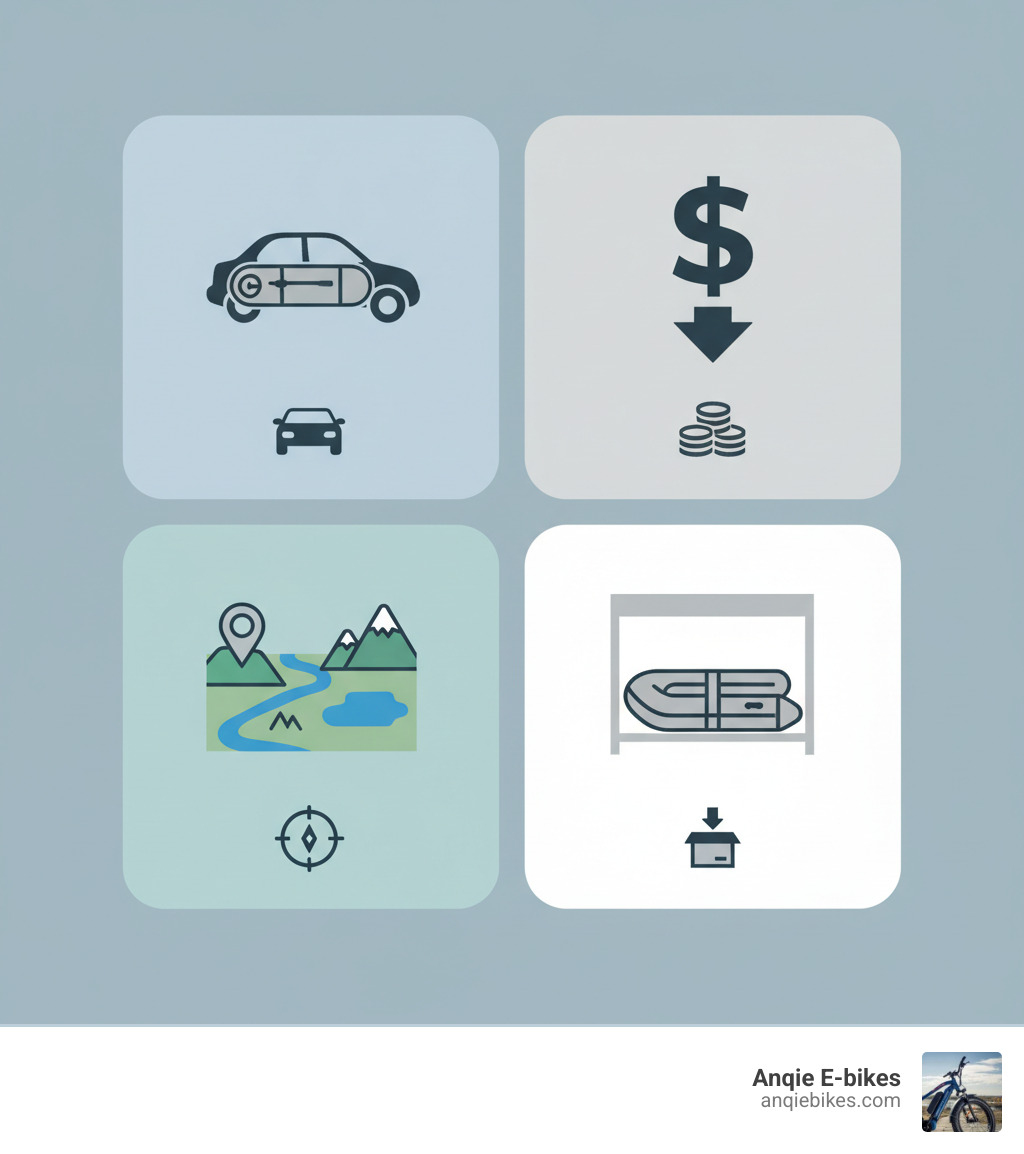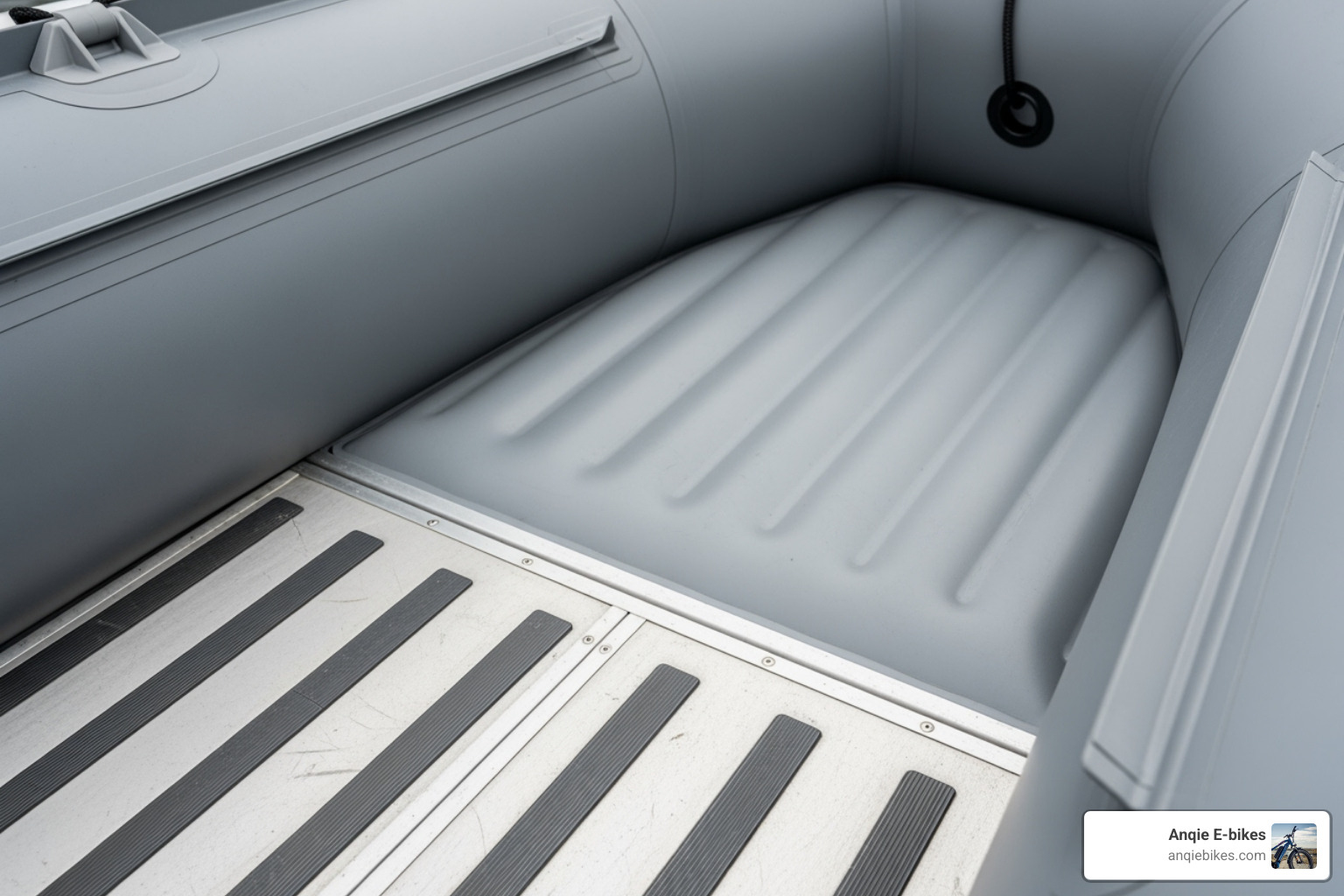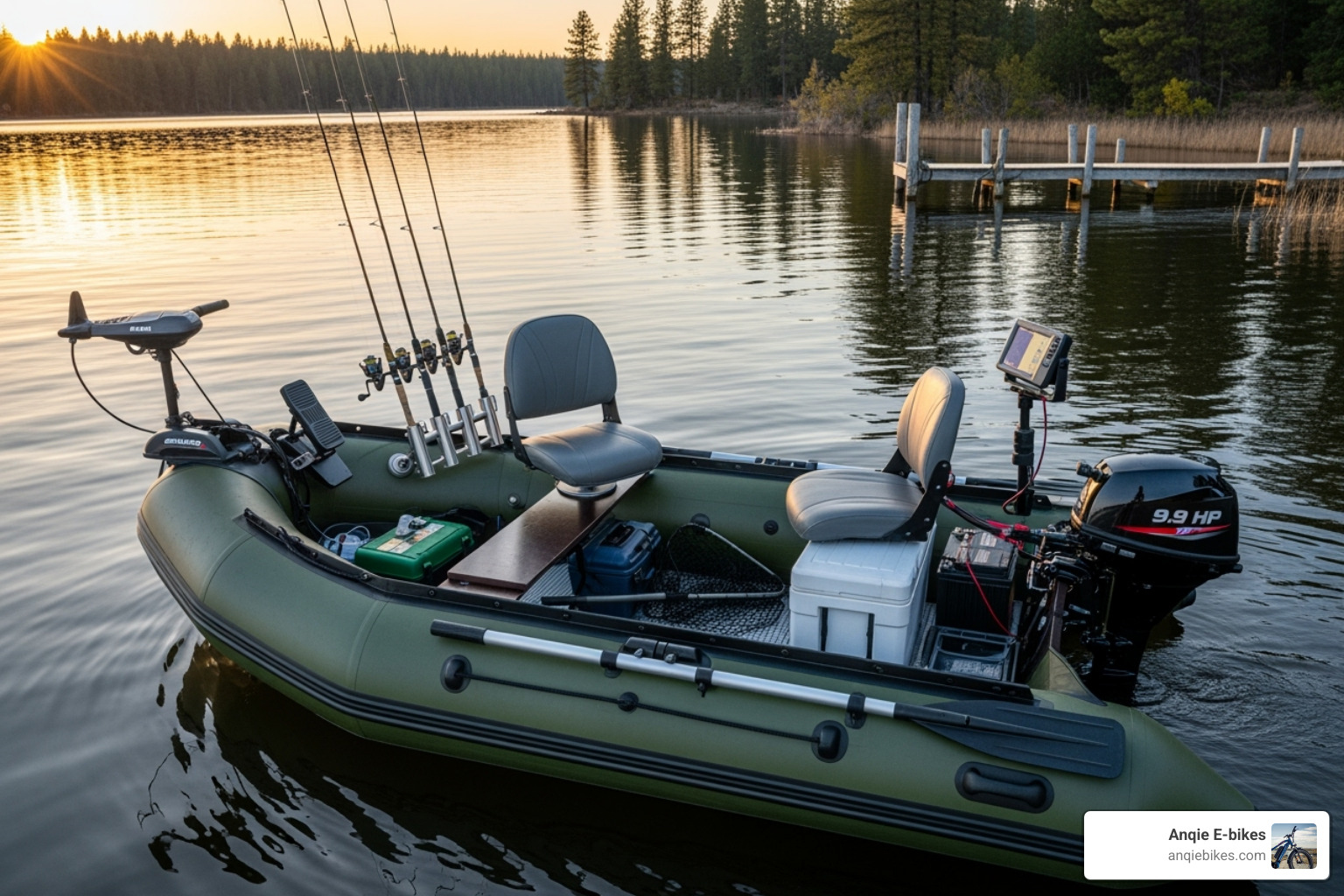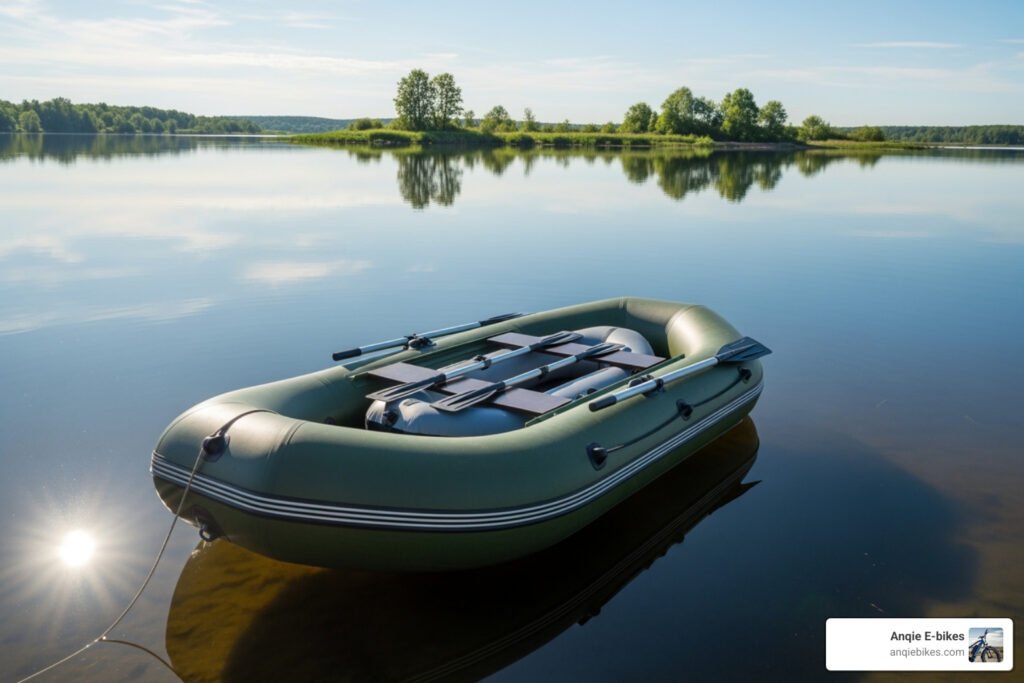Why Inflatable Fishing Boats Are Revolutionizing Modern Angling
An inflatable fishing boat offers anglers best portability and affordability compared to traditional hard-shell boats. These versatile watercraft, typically costing between $500 to $5,000, require no trailer, fit in a car trunk, and provide access to remote fishing spots larger boats cannot reach. With proper maintenance, a quality inflatable can last 10-15 years, making it an excellent long-term investment.
Key Benefits at a Glance:
- Portability – Fits in a car trunk, no trailer required
- Affordability – 50-70% less expensive than traditional boats
- Accessibility – Launch anywhere, reach unfished waters
- Easy Storage – Deflates to compact size for garage or closet storage
- Durability – Modern PVC and Hypalon materials last 10-15 years
The global inflatable boat market, valued at $1.5 billion in 2022, is projected to reach $2.3 billion by 2030. This growth shows that inflatables eliminate common barriers to boating. Today’s models feature military-grade materials, rigid floors, and motor mounts, making them serious angling platforms.
I’m Mark Stark, and my marine industry experience has shown me this change firsthand. I’ve guided countless customers in selecting the ideal inflatable fishing boat for their needs. Let me walk you through what you need to know.

The Inflatable Advantage: Portability, Cost, and Access
The core advantage of an inflatable fishing boat is freedom. Forget trailer logistics, ramp fees, and storage costs; simply pack your boat in your car and go. This is what makes inflatables a game-changer for modern anglers.
Portability: Your Go-Anywhere Fishing Buddy
An inflatable fishing boat eliminates the headaches of traditional watercraft. Most models deflate to a compact size that fits in a car trunk or closet, making transport and storage incredibly simple. You can drive to any spot, unpack, and inflate your boat in minutes. This is a huge benefit for those in apartments or homes with limited space. The Flycrafts Inflatable Fishing Boat Stealth 2.0 Fish Package (2 Man) exemplifies this, packing down small while offering serious fishing capability.
Cost-Effectiveness: More Fishing, Less Spending
Fishing shouldn’t require a second mortgage. Inflatable fishing boats are significantly more affordable than their hard-shell counterparts, with prices typically ranging from $500 to $5,000. The savings continue after the purchase: no trailer to register or maintain, no marina fees, and no expensive storage rentals. Most inflatables use smaller, fuel-efficient motors or even just oars, further reducing costs and making boating accessible to more anglers.
Accessing Remote Fishing Spots: The Untouched Waters Await
Here’s where an inflatable fishing boat truly shines. Its lightweight design allows you to carry it to pristine spots without boat ramps—hidden coves, mountain lakes, and secluded river stretches. This ability to launch without a boat ramp gives you access to unfished waters where fish are less pressured and more willing to bite. You are no longer limited to crowded, developed access points. An inflatable gives you the freedom to explore the entire waterway, not just the convenient parts.
Decoding the Options: Types of Inflatable Craft for Anglers
There is no one-size-fits-all inflatable fishing boat. The market is diverse, with different designs suited to specific fishing styles. Let’s break down the main types.
Inflatable Dinghies/Tenders
Dinghies are the versatile workhorses of the inflatable world. They are stable, practical, and feature a flat or semi-rigid floor, inflatable tubes, and a transom for a small outboard motor. Their open design provides ample room for gear and a fishing buddy, making them ideal for calm lakes, slow rivers, and protected bays. The Achilles SPD Series Inflatable Boat SPD-310E is a prime example of a durable, reliable dinghy.
Rigid Inflatable Boats (RIBs)
RIBs combine a rigid fiberglass or aluminum hull with inflatable side tubes. This hybrid design offers the speed and handling of a traditional boat with the buoyancy and safety of an inflatable. They excel in choppier conditions and can handle more powerful motors, making them ideal for coastal waters or large lakes. A RIB like the Achilles HB-350DX Fiberglass RIB 11.6′ Boat with Honda 30 HP Motor BF30 (2024) offers serious performance, though they typically require a trailer.
Inflatable Kayaks
For solo anglers who value stealth and portability, inflatable kayaks are a perfect choice. These lightweight craft can access shallow backwaters and narrow channels other boats can’t. Modern fishing models are stable enough for standing and casting and come equipped with rod holders and gear tracks.
Inflatable Rafts & Pontoons
Popular with river and fly fishermen, rafts and pontoon boats offer rock-solid stability for standing and casting in moving water. Their two-tube design provides a comfortable platform for all-day fishing, with plenty of room for gear, coolers, and even camping equipment for overnight trips.
KaBoats
KaBoats are a hybrid, blending the agility of a kayak with the functionality of a boat. Their narrow, elongated design and rigid floor provide excellent tracking and speed, whether paddling or using a small motor, while remaining highly portable. They are ideal for covering distance on flat water or navigating rivers with moderate current.
Your Checklist for the Perfect Inflatable Fishing Boat
Choosing the right inflatable fishing boat depends on where and how you fish. Let’s break down the key features to ensure your boat matches your angling style.

Choosing the Right Material and Construction
The boat’s material dictates its lifespan. PVC is a common, affordable, and durable option, with high-quality versions lasting 5-10 years with proper care. Look for multi-layered, high-denier PVC for better puncture resistance. Hypalon is the premium choice, offering superior resistance to UV rays and chemicals, extending the boat’s life to 10-15+ years, making it ideal for heavy use or harsh environments.
Seam construction is also critical. Heat-welded seams fuse the material together for superior durability, especially in warm climates. Glued seams are effective but can degrade over time with UV exposure.
Sizing Up Your Inflatable Fishing Boat
Size your boat based on passengers, gear, and intended use. A small 8-foot dinghy is great for solo trips, while a larger 13-foot model suits family outings.
- Weight Capacity: Always respect the manufacturer’s maximum weight limit, which includes passengers, gear, and the motor. Overloading is unsafe.
- Passenger Capacity: A boat rated for three people may be cramped for three adults with fishing gear. Be realistic about your space needs.
- Gear Storage: Ensure there is enough usable space with D-rings or lacing to secure rods, tackle, and coolers.
Understanding Floor and Transom Types
The floor and transom affect performance, stability, and portability.
| Floor Type | Description | Pros | Cons | Ideal Use |
|---|---|---|---|---|
| High-Pressure Air Deck | Inflatable floor creating a rigid surface | Lightweight, packable, comfortable | Less rigid than solid floors, can be punctured | Calm lakes, portability is key |
| Aluminum/Wood Slats | Rigid slats forming a solid floor | More rigid, durable, stable | Heavier, longer assembly | General-purpose, balance of performance and portability |
| Rigid Fiberglass | Solid one-piece hull (in RIBs) | Maximum rigidity and performance | Heaviest, requires trailer, most expensive | Coastal waters, large lakes, performance-focused anglers |
Air deck floors offer supreme portability and comfort. Wood or aluminum slatted floors provide a more rigid and stable platform. Rigid floors in RIBs, like the Achilles HB-350DX Fiberglass RIB 11.6′ Boat with Honda 30 HP Motor BF30 (2024), deliver the best performance but require a trailer.
A reinforced transom mount is essential for using an outboard motor. Always verify that the boat’s transom is rated for the horsepower and shaft length of the motor you plan to use.
Introduction
Why Inflatable Fishing Boats Are Revolutionizing Modern Angling
An inflatable fishing boat offers anglers best portability and affordability compared to traditional hard-shell boats. These versatile watercraft typically cost between $500 to $5,000, require no trailer, fit in your car trunk, and provide access to remote fishing spots that larger boats simply cannot reach. With proper maintenance, a quality inflatable fishing boat can last 10-15 years, making it an excellent long-term investment for serious anglers.
Key Benefits at a Glance:
- Portability – Fits in a car trunk, no trailer required
- Affordability – 50-70% less expensive than traditional boats
- Accessibility – Launch anywhere, reach unfished waters
- Easy Storage – Deflates to compact size for garage or closet storage
- Durability – Modern PVC and Hypalon materials last 10-15 years
The global inflatable boat market was valued at $1.5 billion in 2022 and is projected to reach $2.3 billion by 2030. This growth reflects what anglers worldwide are finding: inflatable fishing boats eliminate the barriers that once kept people from exploring new waters. No more expensive boat launches, no trailer parking headaches, and no storage unit fees.
Whether you’re targeting bass on hidden farm ponds, fly fishing remote mountain streams, or casting for saltwater species in coastal bays, an inflatable fishing boat opens up possibilities that simply weren’t practical before. These boats have evolved far beyond the cheap pool toys of decades past—today’s models feature military-grade materials, rigid floors, motor mounts, and specialized fishing features.
I’m Mark Stark, and my experience in the marine industry has shown me how inflatable fishing boats have transformed from novelty items into serious angling platforms. I’ve guided countless customers through selecting the ideal inflatable fishing boat for their specific needs, from solo kayak anglers to families seeking weekend adventures. Let me walk you through everything you need to know to make the right choice.
The Inflatable Advantage: Portability, Cost, and Access
When we talk about the advantages of an inflatable fishing boat, we’re really talking about a revolution in how we approach fishing. Traditional boats, while fantastic for certain scenarios, come with a host of logistical challenges. Inflatables, on the other hand, tackle these head-on, offering unparalleled freedom and flexibility.
Portability: Your Go-Anywhere Fishing Buddy
Imagine this: no more struggling with boat trailers, no more trying to back a trailer down a crowded ramp, and certainly no more paying for expensive storage facilities. That’s the dream an inflatable fishing boat makes a reality. These boats are designed for ultimate portability. Many models, especially smaller ones like the Flycrafts Inflatable Fishing Boat Stealth 2.0, can literally fit in the trunk of a car when deflated. This means we can take our fishing adventures virtually anywhere the road leads, from a serene lake tucked away in the mountains to a quiet river bend rarely visited by others.
The ease of transport is a game-changer. We simply pack our boat, gear, and a pump, and we’re off. Setting up is usually a straightforward process, and breaking down is just as simple. This eliminates the need for a dedicated boat ramp, allowing us to launch from almost any shoreline. This portability also means easier storage at home, whether it’s in a garage, shed, or even a large closet. For urban anglers, like those of us in Brooklyn, NY, with limited space, this is a huge benefit.
Cost-Effectiveness: More Fishing, Less Spending
Let’s face it, fishing can be an expensive hobby. Traditional boats come with hefty price tags, not to mention ongoing costs for trailers, storage, maintenance, and fuel. Inflatable fishing boats offer a refreshing alternative, being significantly more cost-effective. The research shows prices typically ranging from $500 to $5,000, depending on size, features, and brand. This is often 50-70% less than a comparable hard-shell boat.
Beyond the initial purchase, the savings continue. There’s no trailer to register or maintain, no need for a marina slip, and often, smaller, more fuel-efficient motors (or even electric trolling motors) are sufficient, further reducing operating costs. This lower financial barrier makes boating and fishing accessible to a much broader audience, aligning with the growing popularity of recreational fishing.
Accessing Remote Fishing Spots: The Untouched Waters Await
One of the most compelling reasons to choose an inflatable fishing boat is its ability to access remote or hard-to-reach fishing spots. We’ve all seen those tantalizing stretches of water that look perfect for fishing but are inaccessible by traditional means. Inflatables change that. Their lightweight nature allows us to carry them over obstacles, portage them around rapids, or simply launch them from undeveloped shorelines where no ramp exists.
This capability opens up a world of unfished or lightly fished waters, often leading to more productive and peaceful angling experiences. Imagine being the only angler on a pristine mountain lake, or drifting down a secluded river, casting into untouched pools. This is where an inflatable fishing boat truly shines, giving us the freedom to explore and find hidden gems.
For example, models like the Flycrafts Inflatable Fishing Boat Stealth 2.0 Fish Package (2 Man) are specifically designed for this kind of adventure, combining the comforts of a drift boat with the accessibility of a lightweight inflatable. These boats fit in the trunk of a car, eliminate the need for a trailer, and are perfect for reaching those remote, uncrowded fishing holes that trophy fish often call home.
Decoding the Options: Types of Inflatable Craft for Anglers
When we start shopping for an inflatable fishing boat, it’s easy to feel overwhelmed by the sheer variety of options. The truth is, “inflatable fishing boat” is a pretty broad term that covers everything from sleek kayaks to sturdy rafts. Each type has its own personality and purpose, and understanding these differences will help us find the perfect match for our fishing style.
Inflatable Dinghies/Tenders
Think of inflatable dinghies as the reliable workhorses of the inflatable world. These versatile boats are the ones you often see tied to the back of yachts, but don’t let that fool you—they make outstanding fishing platforms. What I love about dinghies is their straightforward design: stable, roomy enough for gear and a fishing buddy, and they typically feature a flat or semi-rigid floor that makes standing and casting much easier.
Most dinghies come with transom mounts, which means we can attach a small outboard motor and cover more water. Their open layout gives us plenty of room to move around and organize our tackle boxes, coolers, and rods. These boats shine on calm lakes, slow-moving rivers, and protected bays where the water stays relatively peaceful.
The Achilles SPD Series Inflatable Boat SPD-310E represents the quality end of the dinghy spectrum—built tough and designed to last. For anglers just getting started, there are also budget-friendly options that deliver solid performance without breaking the bank. Dinghies strike that sweet spot between portability and capacity, making them incredibly popular among weekend anglers.
Rigid Inflatable Boats (RIBs)
Now, if dinghies are the workhorses, Rigid Inflatable Boats (RIBs) are the thoroughbreds. These boats combine a rigid hull—either fiberglass or aluminum—with inflatable tubes running along the sides. It’s a hybrid design that brings together the best qualities of both worlds: the speed, stability, and handling of a hard-shell boat, plus the buoyancy and shock absorption of an inflatable.
RIBs are noticeably faster and more maneuverable than full inflatables, and they handle rougher conditions with confidence. If we’re planning to fish coastal waters, tackle larger lakes, or venture into areas where the weather can turn unpredictable, a RIB becomes an excellent investment. Yes, they’re less portable than full inflatables and usually need a trailer, but the trade-off is a boat that performs more like a traditional vessel while maintaining superior safety features.
The Achilles HB-350DX Fiberglass RIB 11.6′ Boat with Honda 30 HP Motor BF30 (2024) is a perfect example of what serious anglers can achieve with a high-performance RIB. These boats don’t just get us to the fishing spot—they make the journey part of the adventure.
Inflatable Kayaks
For those of us who fish solo or crave the ultimate in portability and stealth, inflatable fishing kayaks are hard to beat. These lightweight craft are incredibly easy to paddle, and they can slip into spaces that other boats simply can’t reach—tight creek channels, shallow flats, and narrow passages through vegetation.
Many inflatable kayaks designed for fishing come loaded with thoughtful features: rod holders, gear tracks for mounting accessories, and surprisingly stable platforms that even allow for standing casts. The stability of modern inflatable kayaks often surprises first-time users, especially models with wider profiles or outrigger designs.
These kayaks excel in small ponds, narrow rivers, and calm coastal estuaries where maneuverability matters more than speed. They pack down small enough to fit in a large backpack, making them the go-to choice for anglers who hike to remote fishing spots or travel frequently.
Inflatable Rafts & Pontoons
While most people associate rafts with whitewater adventures, inflatable rafts equipped with fishing frames have carved out a devoted following among anglers, particularly those who love river fishing and fly fishing. The same goes for pontoon boats, which feature two large inflatable tubes connected by a frame.
What makes these boats special is their exceptional stability. We can stand all day casting without feeling wobbly, which is crucial for fly fishing or working lures with precision. Pontoon boats often come with comfortable seats, rowing frames, and enough space to mount small motors for longer drifts.
Both rafts and pontoons provide generous room for gear, coolers, and multiple anglers, making them ideal for full-day fishing trips. They’re built to drift rivers smoothly, and many models can handle moderate rapids if we’re chasing trout in moving water. The design philosophy behind boats like the Flycraft inflatable fishing boats is simple: create one versatile craft that can replace several specialized boats, whether we’re drifting a lazy river or tackling a mountain stream.
KaBoats
Here’s where things get interesting. KaBoats are the clever hybrids that blend kayak agility with boat functionality. Picture a narrow, elongated design with high-pressure inflatable tubes and typically a flat, rigid floor. This combination delivers excellent tracking and speed whether we’re paddling or using a small motor, all while maintaining the packability of an inflatable.
KaBoats really shine when we need to cover distance on flat water or steer rivers with moderate current. They track straighter than most inflatables, making them less tiring for long paddles. The stable platform works beautifully for fishing, and the weight capacity usually accommodates all the gear we need for a serious day on the water. Think of them as the sport sedans of the inflatable world—efficient, capable, and surprisingly fun to handle.
Gearing Up: Essential Accessories and Power
Once you’ve chosen your inflatable fishing boat, it’s time to outfit it as your personal fishing command center.

Propulsion Options: Getting Where the Fish Are
- Oars: The classic choice. They are quiet, reliable, and require no fuel. Perfect for stealthy approaches in calm water.
- Electric Trolling Motors: Whisper-quiet for precise positioning without spooking fish. Battery life is the main consideration. The E-propulsion Spirit 1.0 Plus is a great example of modern electric power.
- Gas Outboard Motors: The best option for covering long distances or handling strong currents. Always check your boat’s maximum horsepower rating and required shaft length (usually 15″ short shaft). A capable RIB matched with a quality motor, like the Highfield Ultralite UL-340FD FCT Aluminum RIB 11.1′ Boat with Tohatsu 20 HP Motor MFS20 (2023), offers serious performance.
Must-Have Fishing Gear & Accessories
- Rod Holders: Essential for keeping rods secure and hands-free.
- Fish Finders: Compact, battery-powered units reveal underwater structure and fish.
- Comfortable Seating: Upgrading from basic benches to a swivel seat improves comfort for long days.
- Storage Solutions: Use dry bags for valuables and secure tackle boxes and coolers with D-rings or cargo nets.
- Anchor: Holds your position over a productive spot.
- Pump: An electric pump saves time and effort.
- Repair Kit: A must-have for quick, on-the-water patches.
Safety Equipment: Better Safe Than Sorry!
Safety is non-negotiable. Always carry:
- Life Vests (PFDs): One Coast Guard-approved PFD for every person on board is mandatory.
- Signaling Device: A whistle or horn for emergencies.
- Backup Paddle: Crucial even if you have a motor.
- First-Aid Kit: For minor injuries.
- Sun Protection: Sunscreen, hats, and protective clothing are vital.
- VHF Radio: Essential for weather updates and communication in coastal waters.
Frequently Asked Questions about Inflatable Fishing Boats
Let’s tackle the most common questions about owning and operating an inflatable fishing boat.
How do I maintain my boat for longevity?
Proper care ensures your inflatable fishing boat will last 10-15 years.
- Clean: Rinse with fresh water after each use, especially in saltwater. Use mild soap for stubborn dirt.
- Store: Keep it in a cool, dry place away from direct sun. Storing it partially inflated is ideal to prevent creases. Ensure it’s completely dry if deflating for compact storage to prevent mold.
- Protect: Apply a UV protectant spray regularly to prevent sun damage.
- Repair: Small punctures are easily fixed with the included repair kit. Practice a patch at home so you’re prepared.
What are the safety and legal requirements?
- Registration: Requirements vary by state based on boat length and motor use. Check with your local boating authority.
- Safety Gear: Beyond mandatory PFDs for everyone, you may need a horn, fire extinguisher (with gas motors), and visual distress signals. Always know and carry the required equipment.
- Capacity Limits: Never exceed the boat’s maximum weight and passenger capacity listed by the manufacturer. This includes people, gear, and the motor.
- Local Rules: Research local regulations like horsepower limits or no-wake zones before you go. Join a community of fellow anglers to discuss regulations and share tips.
Can I use an inflatable boat in the ocean?
Yes, many inflatable fishing boats are excellent for saltwater use, provided you match the boat to the conditions.
- Best Use: Most inflatables are perfect for calm coastal waters, bays, and estuaries.
- Rougher Water: For open water or larger waves, a Rigid Inflatable Boat (RIB) is the best choice. Its rigid hull provides superior handling and wave-cutting ability.
- Weather: Always check the marine forecast. Wind and waves can change quickly, and small boats can be easily overwhelmed. Postpone your trip if conditions are questionable.
- Saltwater Care: Rinse your boat thoroughly with fresh water after every ocean trip to prevent salt corrosion and protect your investment.
Conclusion: Your Next Adventure Awaits
An inflatable fishing boat represents freedom: freedom from trailers, high costs, and limited access. It’s your ticket to exploring hidden fishing spots and creating unforgettable memories. With the right knowledge of materials, types, and accessories, you can confidently choose a boat that will serve you for a decade or more.
The versatility is remarkable, with options ranging from nimble kayaks for solo anglers to spacious dinghies for families and robust RIBs for serious open-water pursuits. Proper care is simple and ensures your investment pays off with years of reliable service.
At Anqie E-bikes, we’re passionate about getting people on the water. Our team offers expert guidance, a comprehensive selection of products, and the after-sales support to ensure your success. We don’t just sell boats; we help you access adventures.
Your next great fishing story is waiting to be written. It all starts with taking the first step.
Explore our complete collection of high-performance boats and motors and let’s get you ready for the adventure that’s calling your name. The water is waiting.

